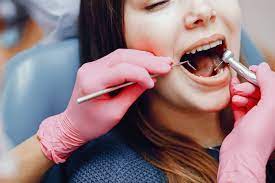Tooth extraction is a common dental procedure that may be necessary due to various reasons, including severe decay, damage, or overcrowding. Whether it's a simple extraction or a more complex surgical procedure, understanding the recovery process is crucial for a smooth and comfortable healing experience. In Tooth Extraction In Dubai, where advanced dental care is readily available, knowing the right steps to take post-extraction can help you avoid complications and promote optimal recovery.
Understanding the Extraction Procedure
Tooth extraction involves the removal of a tooth from its socket in the jawbone. The procedure can range from straightforward to complex depending on the tooth’s position and the condition of the surrounding tissues. The extraction process generally includes:
Anesthesia:
Local anesthesia is used to numb the area, ensuring you are comfortable during the procedure. For more complex extractions, sedation or general anesthesia might be administered.
Extraction:
The dentist will gently loosen the tooth using specialized instruments and then remove it from the socket.
Post-Procedure Care:
After the extraction, the dentist will provide instructions for managing the wound and preventing infection.
Immediate Post-Extraction Care
The initial hours following a tooth extraction are critical for effective recovery. Here are some essential tips to follow:
Bite on Gauze:
After the procedure, the dentist will place a gauze pad over the extraction site. Bite down gently to help form a blood clot and minimize bleeding. Change the gauze as needed, but avoid excessive spitting or rinsing, which can dislodge the clot.
Rest:
Rest is vital to aid the healing process. Avoid strenuous activities for at least 24 hours to prevent complications. Reclining with your head elevated can also help reduce swelling.
Pain Management:
Mild discomfort is common after an extraction. Over-the-counter pain relievers like ibuprofen or acetaminophen can help manage pain. If prescribed, take any medications as directed by your dentist.
Ice Packs:
Applying an ice pack to the outside of your face near the extraction site can reduce swelling and numb the area. Use the ice pack in 15-minute intervals to avoid skin irritation.
Diet and Nutrition
Diet plays a crucial role in the recovery process. For the first few days following your extraction, adhere to these dietary recommendations:
Soft Foods:
Stick to soft, cool foods such as yogurt, mashed potatoes, applesauce, and smoothies. Avoid hard, crunchy, or sticky foods that can irritate the extraction site or dislodge the blood clot.
Avoid Hot Beverages:
Hot drinks and foods can increase swelling and discomfort. Opt for lukewarm or cool beverages instead.
Hydration: Stay hydrated by drinking plenty of fluids. However, avoid using a straw, as the suction can interfere with clot formation and lead to a condition called dry socket.
Oral Hygiene
Maintaining good oral hygiene is essential to prevent infection and promote healing:
Gentle Brushing:
Resume brushing your teeth the day after the extraction, but be careful to avoid the extraction site. Use a soft-bristled toothbrush and gentle brushing techniques.
Avoid Rinsing:
For the first 24 hours, avoid rinsing your mouth. After this period, you can start rinsing gently with a saltwater solution to help keep the area clean.
Professional Cleanings:
Follow up with your dentist as advised to ensure proper healing and to address any concerns.
Managing Potential Complications
While most tooth extractions heal without issues, being aware of potential complications can help you take prompt action if needed:
Dry Socket:
This condition occurs when the blood clot at the extraction site becomes dislodged or dissolves, exposing the bone. Symptoms include severe pain and bad breath. If you suspect a dry socket, contact your dentist immediately for treatment.
Infection:
Signs of infection include increased pain, swelling, redness, or pus at the extraction site. If you experience any of these symptoms, seek prompt medical attention.
Swelling and Bruising:
It’s normal to experience some swelling and bruising. If the swelling worsens or does not improve after a few days, consult your dentist.
Follow-Up Care
Follow-up appointments with your dentist are essential to ensure that your extraction site is healing correctly. During these visits, your dentist will:
Check the Healing Process: Assess the extraction site and ensure there are no complications.
Provide Additional Instructions: Offer further advice on oral care and answer any questions you may have.
Discuss Future Treatment: If the extraction was part of a larger treatment plan, discuss the next steps, such as replacement options or further procedures.
Special Considerations in Dubai
In Dubai, advanced dental clinics and state-of-the-art technology are readily available, providing top-notch care throughout your recovery. However, it’s essential to choose a reputable dental clinic with experienced professionals to ensure a smooth extraction and recovery process. Consider the following tips for selecting the right dental care provider:
Research Clinics: Look for clinics with positive reviews, experienced dentists, and modern facilities.
Verify Credentials: Ensure that the dental professionals are licensed and have the necessary qualifications.
Consultation: Schedule a consultation to discuss your concerns, understand the procedure, and receive personalized recovery advice.
Conclusion
Recovering from a tooth extraction involves careful attention to post-procedure care, diet, and hygiene. By following these tips and seeking professional guidance, you can ensure a smooth and comfortable recovery process. In Dubai, where high-quality dental care is available, you can trust that you’re in capable hands. Remember to follow your dentist’s instructions, maintain good oral hygiene, and address any concerns promptly to achieve the best possible outcome.






Comments